NRSG138: Reflection on Roper, Logan & Tierney Model & Nursing Practice
VerifiedAdded on 2023/04/25
|8
|1963
|333
Essay
AI Summary
This essay is a reflective piece on the student's learning experience with the Roper, Logan, and Tierney (RLT) model in nursing, specifically within the context of the NRSG138 course, Transition to Nursing. The reflection follows Gibbs' reflective cycle, covering description, feelings, evaluation, analysis, conclusion, and action plan. It explores how understanding the RLT model's domains—biological, psychological, socio-cultural, politico-economic, and environmental factors—contributes to the student's professional philosophy and intention to practice person-centered care. The essay highlights the importance of self-care in patient well-being and how the RLT model facilitates comprehensive patient assessment and individualized care planning. The conclusion emphasizes the commitment to patients and improved health outcomes, advocating for the incorporation of the RLT model in future nursing practice for holistic patient care. The action plan outlines steps for expanding clinical knowledge and implementing the RLT model effectively.
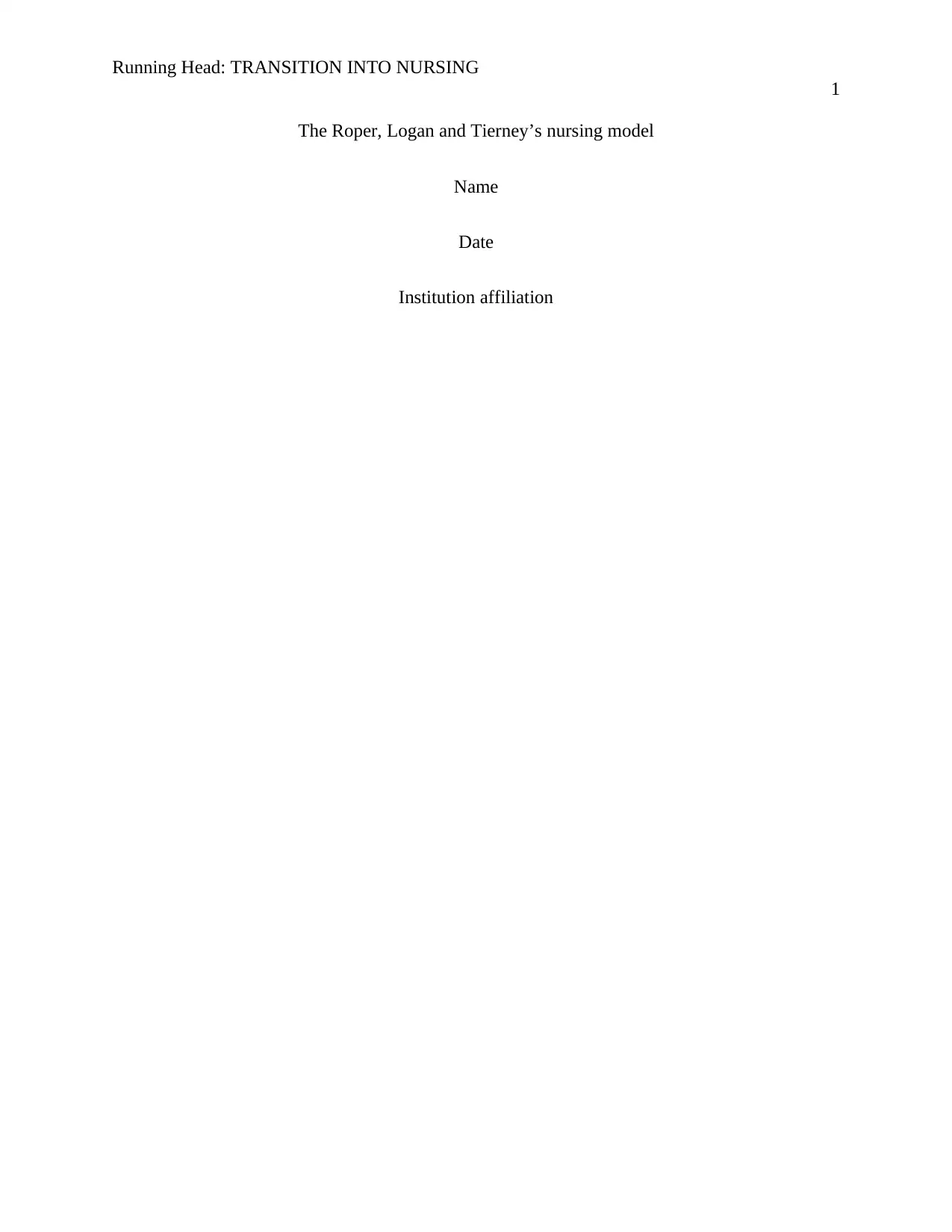
Running Head: TRANSITION INTO NURSING
1
The Roper, Logan and Tierney’s nursing model
Name
Date
Institution affiliation
1
The Roper, Logan and Tierney’s nursing model
Name
Date
Institution affiliation
Secure Best Marks with AI Grader
Need help grading? Try our AI Grader for instant feedback on your assignments.
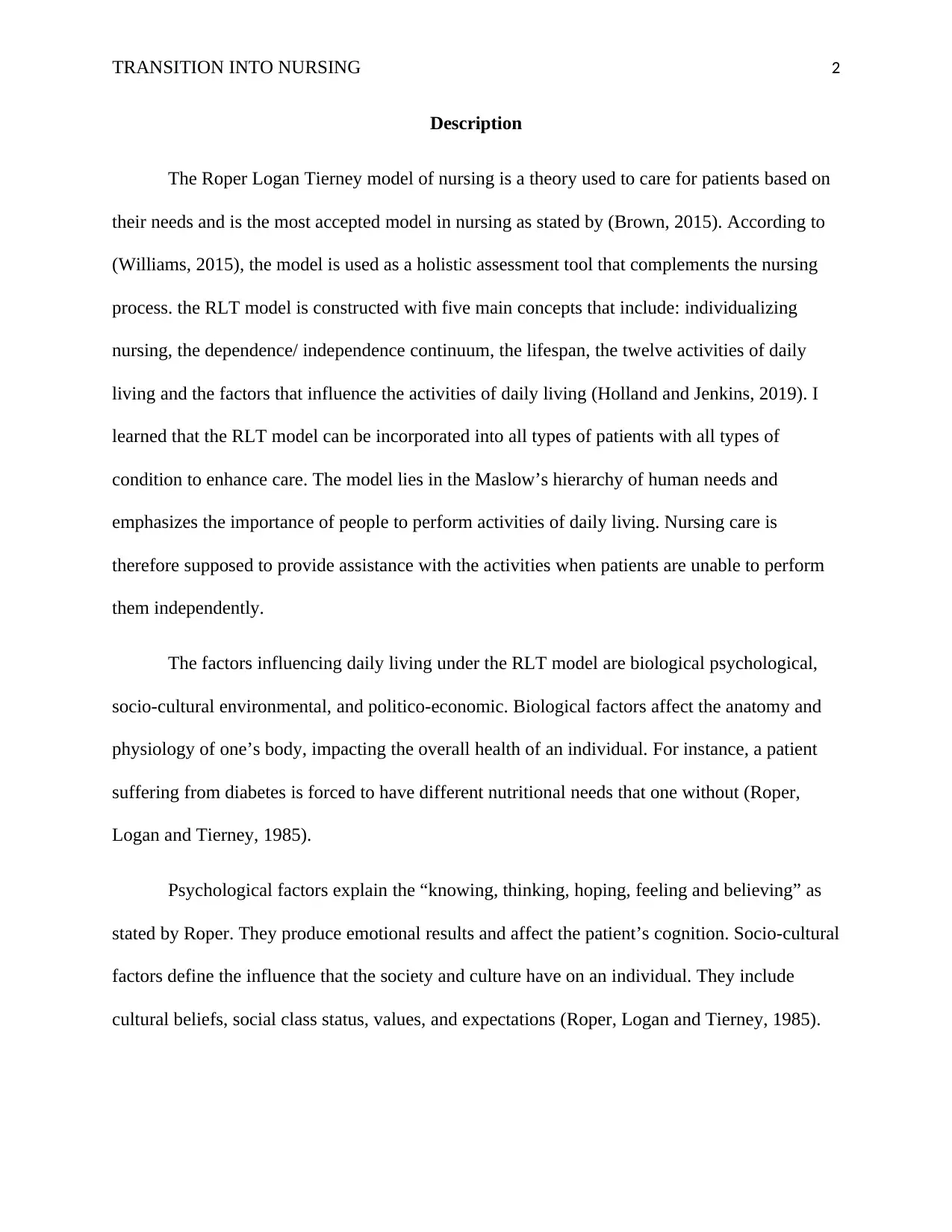
TRANSITION INTO NURSING 2
Description
The Roper Logan Tierney model of nursing is a theory used to care for patients based on
their needs and is the most accepted model in nursing as stated by (Brown, 2015). According to
(Williams, 2015), the model is used as a holistic assessment tool that complements the nursing
process. the RLT model is constructed with five main concepts that include: individualizing
nursing, the dependence/ independence continuum, the lifespan, the twelve activities of daily
living and the factors that influence the activities of daily living (Holland and Jenkins, 2019). I
learned that the RLT model can be incorporated into all types of patients with all types of
condition to enhance care. The model lies in the Maslow’s hierarchy of human needs and
emphasizes the importance of people to perform activities of daily living. Nursing care is
therefore supposed to provide assistance with the activities when patients are unable to perform
them independently.
The factors influencing daily living under the RLT model are biological psychological,
socio-cultural environmental, and politico-economic. Biological factors affect the anatomy and
physiology of one’s body, impacting the overall health of an individual. For instance, a patient
suffering from diabetes is forced to have different nutritional needs that one without (Roper,
Logan and Tierney, 1985).
Psychological factors explain the “knowing, thinking, hoping, feeling and believing” as
stated by Roper. They produce emotional results and affect the patient’s cognition. Socio-cultural
factors define the influence that the society and culture have on an individual. They include
cultural beliefs, social class status, values, and expectations (Roper, Logan and Tierney, 1985).
Description
The Roper Logan Tierney model of nursing is a theory used to care for patients based on
their needs and is the most accepted model in nursing as stated by (Brown, 2015). According to
(Williams, 2015), the model is used as a holistic assessment tool that complements the nursing
process. the RLT model is constructed with five main concepts that include: individualizing
nursing, the dependence/ independence continuum, the lifespan, the twelve activities of daily
living and the factors that influence the activities of daily living (Holland and Jenkins, 2019). I
learned that the RLT model can be incorporated into all types of patients with all types of
condition to enhance care. The model lies in the Maslow’s hierarchy of human needs and
emphasizes the importance of people to perform activities of daily living. Nursing care is
therefore supposed to provide assistance with the activities when patients are unable to perform
them independently.
The factors influencing daily living under the RLT model are biological psychological,
socio-cultural environmental, and politico-economic. Biological factors affect the anatomy and
physiology of one’s body, impacting the overall health of an individual. For instance, a patient
suffering from diabetes is forced to have different nutritional needs that one without (Roper,
Logan and Tierney, 1985).
Psychological factors explain the “knowing, thinking, hoping, feeling and believing” as
stated by Roper. They produce emotional results and affect the patient’s cognition. Socio-cultural
factors define the influence that the society and culture have on an individual. They include
cultural beliefs, social class status, values, and expectations (Roper, Logan and Tierney, 1985).
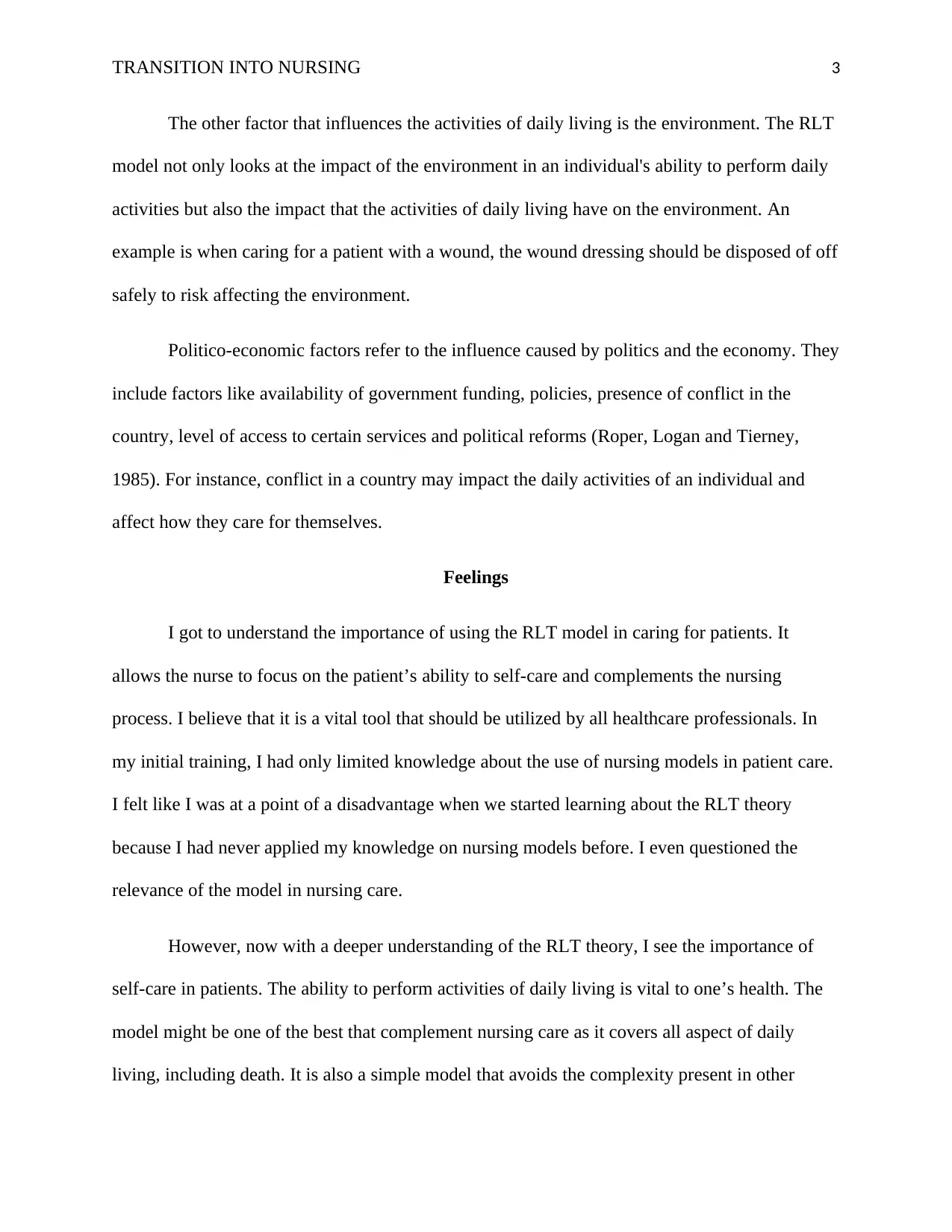
TRANSITION INTO NURSING 3
The other factor that influences the activities of daily living is the environment. The RLT
model not only looks at the impact of the environment in an individual's ability to perform daily
activities but also the impact that the activities of daily living have on the environment. An
example is when caring for a patient with a wound, the wound dressing should be disposed of off
safely to risk affecting the environment.
Politico-economic factors refer to the influence caused by politics and the economy. They
include factors like availability of government funding, policies, presence of conflict in the
country, level of access to certain services and political reforms (Roper, Logan and Tierney,
1985). For instance, conflict in a country may impact the daily activities of an individual and
affect how they care for themselves.
Feelings
I got to understand the importance of using the RLT model in caring for patients. It
allows the nurse to focus on the patient’s ability to self-care and complements the nursing
process. I believe that it is a vital tool that should be utilized by all healthcare professionals. In
my initial training, I had only limited knowledge about the use of nursing models in patient care.
I felt like I was at a point of a disadvantage when we started learning about the RLT theory
because I had never applied my knowledge on nursing models before. I even questioned the
relevance of the model in nursing care.
However, now with a deeper understanding of the RLT theory, I see the importance of
self-care in patients. The ability to perform activities of daily living is vital to one’s health. The
model might be one of the best that complement nursing care as it covers all aspect of daily
living, including death. It is also a simple model that avoids the complexity present in other
The other factor that influences the activities of daily living is the environment. The RLT
model not only looks at the impact of the environment in an individual's ability to perform daily
activities but also the impact that the activities of daily living have on the environment. An
example is when caring for a patient with a wound, the wound dressing should be disposed of off
safely to risk affecting the environment.
Politico-economic factors refer to the influence caused by politics and the economy. They
include factors like availability of government funding, policies, presence of conflict in the
country, level of access to certain services and political reforms (Roper, Logan and Tierney,
1985). For instance, conflict in a country may impact the daily activities of an individual and
affect how they care for themselves.
Feelings
I got to understand the importance of using the RLT model in caring for patients. It
allows the nurse to focus on the patient’s ability to self-care and complements the nursing
process. I believe that it is a vital tool that should be utilized by all healthcare professionals. In
my initial training, I had only limited knowledge about the use of nursing models in patient care.
I felt like I was at a point of a disadvantage when we started learning about the RLT theory
because I had never applied my knowledge on nursing models before. I even questioned the
relevance of the model in nursing care.
However, now with a deeper understanding of the RLT theory, I see the importance of
self-care in patients. The ability to perform activities of daily living is vital to one’s health. The
model might be one of the best that complement nursing care as it covers all aspect of daily
living, including death. It is also a simple model that avoids the complexity present in other
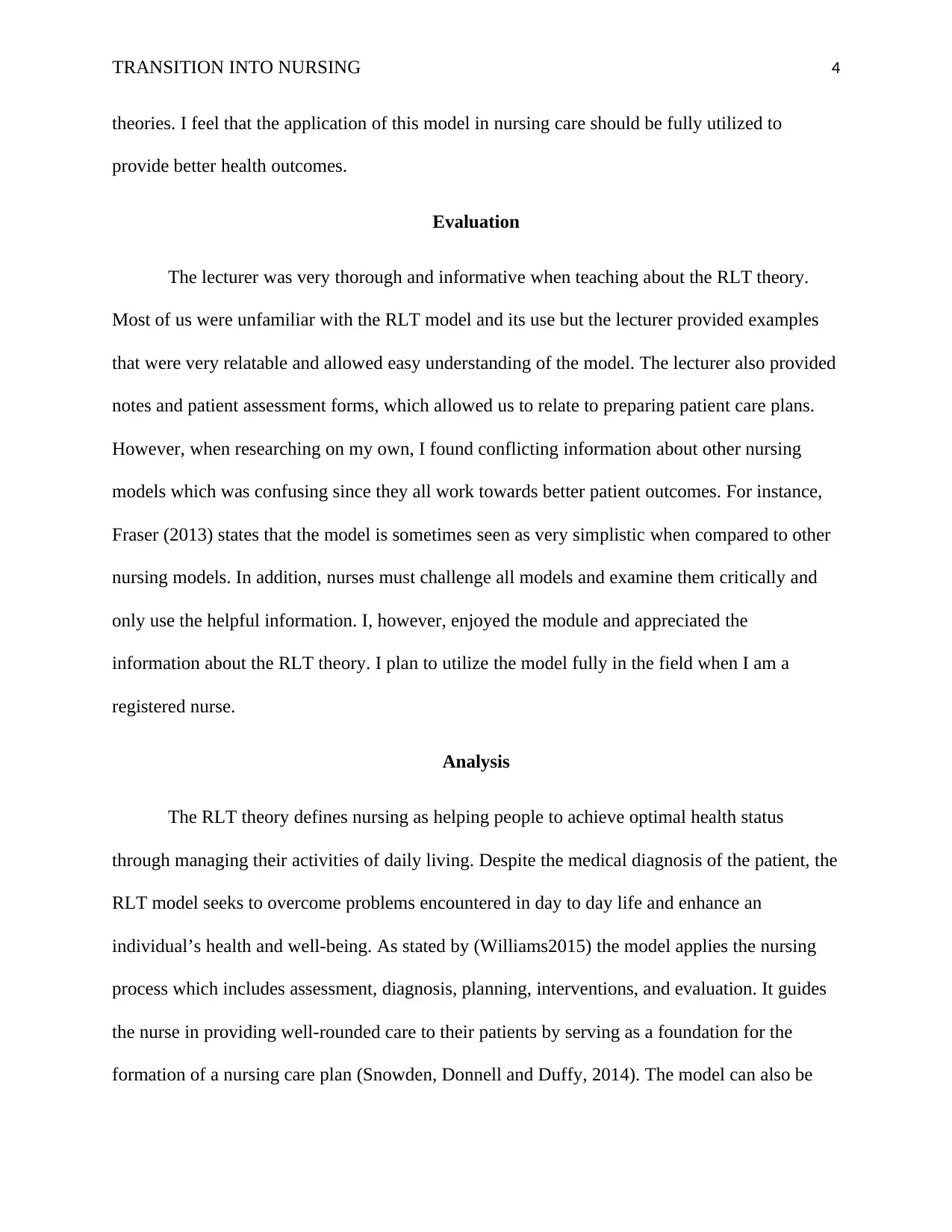
TRANSITION INTO NURSING 4
theories. I feel that the application of this model in nursing care should be fully utilized to
provide better health outcomes.
Evaluation
The lecturer was very thorough and informative when teaching about the RLT theory.
Most of us were unfamiliar with the RLT model and its use but the lecturer provided examples
that were very relatable and allowed easy understanding of the model. The lecturer also provided
notes and patient assessment forms, which allowed us to relate to preparing patient care plans.
However, when researching on my own, I found conflicting information about other nursing
models which was confusing since they all work towards better patient outcomes. For instance,
Fraser (2013) states that the model is sometimes seen as very simplistic when compared to other
nursing models. In addition, nurses must challenge all models and examine them critically and
only use the helpful information. I, however, enjoyed the module and appreciated the
information about the RLT theory. I plan to utilize the model fully in the field when I am a
registered nurse.
Analysis
The RLT theory defines nursing as helping people to achieve optimal health status
through managing their activities of daily living. Despite the medical diagnosis of the patient, the
RLT model seeks to overcome problems encountered in day to day life and enhance an
individual’s health and well-being. As stated by (Williams2015) the model applies the nursing
process which includes assessment, diagnosis, planning, interventions, and evaluation. It guides
the nurse in providing well-rounded care to their patients by serving as a foundation for the
formation of a nursing care plan (Snowden, Donnell and Duffy, 2014). The model can also be
theories. I feel that the application of this model in nursing care should be fully utilized to
provide better health outcomes.
Evaluation
The lecturer was very thorough and informative when teaching about the RLT theory.
Most of us were unfamiliar with the RLT model and its use but the lecturer provided examples
that were very relatable and allowed easy understanding of the model. The lecturer also provided
notes and patient assessment forms, which allowed us to relate to preparing patient care plans.
However, when researching on my own, I found conflicting information about other nursing
models which was confusing since they all work towards better patient outcomes. For instance,
Fraser (2013) states that the model is sometimes seen as very simplistic when compared to other
nursing models. In addition, nurses must challenge all models and examine them critically and
only use the helpful information. I, however, enjoyed the module and appreciated the
information about the RLT theory. I plan to utilize the model fully in the field when I am a
registered nurse.
Analysis
The RLT theory defines nursing as helping people to achieve optimal health status
through managing their activities of daily living. Despite the medical diagnosis of the patient, the
RLT model seeks to overcome problems encountered in day to day life and enhance an
individual’s health and well-being. As stated by (Williams2015) the model applies the nursing
process which includes assessment, diagnosis, planning, interventions, and evaluation. It guides
the nurse in providing well-rounded care to their patients by serving as a foundation for the
formation of a nursing care plan (Snowden, Donnell and Duffy, 2014). The model can also be
Secure Best Marks with AI Grader
Need help grading? Try our AI Grader for instant feedback on your assignments.
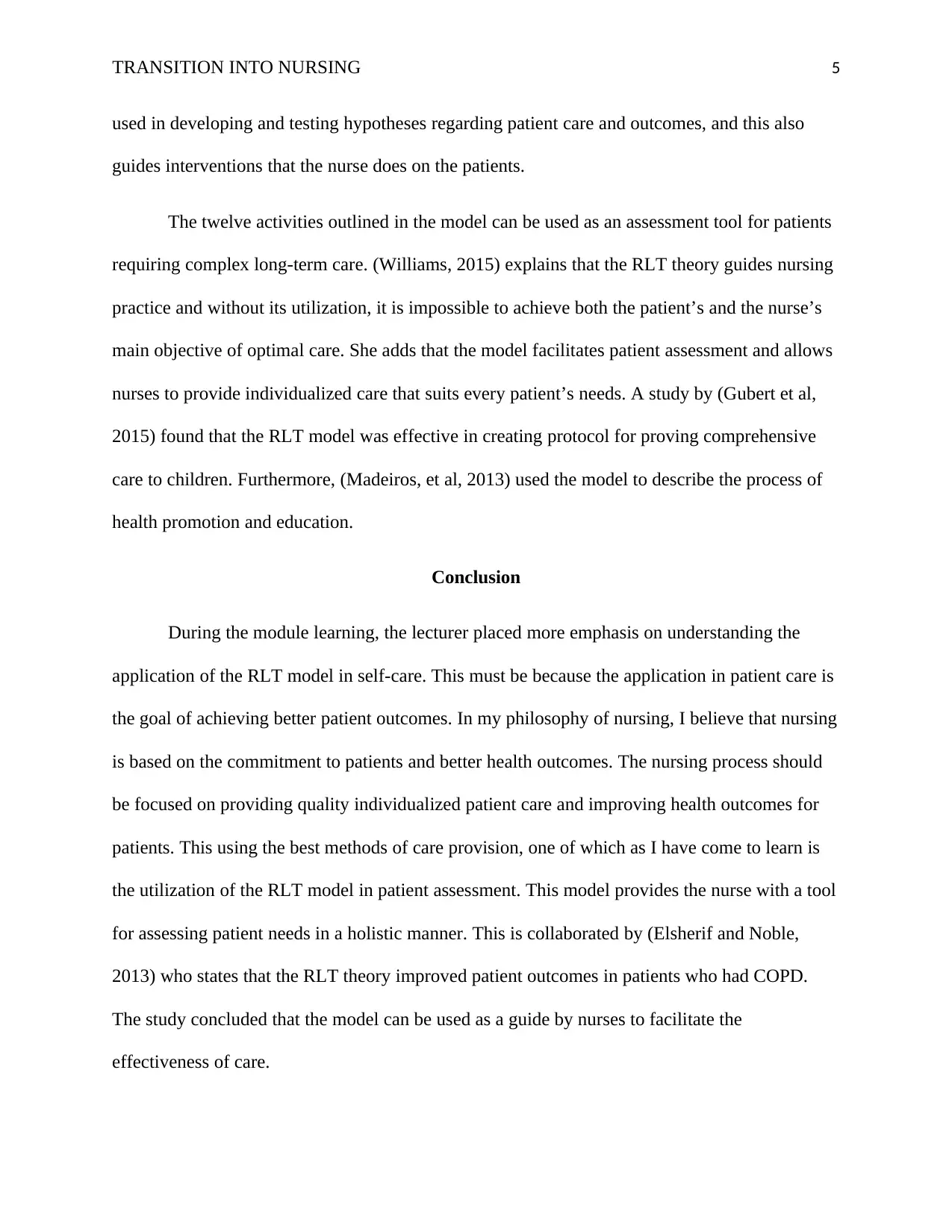
TRANSITION INTO NURSING 5
used in developing and testing hypotheses regarding patient care and outcomes, and this also
guides interventions that the nurse does on the patients.
The twelve activities outlined in the model can be used as an assessment tool for patients
requiring complex long-term care. (Williams, 2015) explains that the RLT theory guides nursing
practice and without its utilization, it is impossible to achieve both the patient’s and the nurse’s
main objective of optimal care. She adds that the model facilitates patient assessment and allows
nurses to provide individualized care that suits every patient’s needs. A study by (Gubert et al,
2015) found that the RLT model was effective in creating protocol for proving comprehensive
care to children. Furthermore, (Madeiros, et al, 2013) used the model to describe the process of
health promotion and education.
Conclusion
During the module learning, the lecturer placed more emphasis on understanding the
application of the RLT model in self-care. This must be because the application in patient care is
the goal of achieving better patient outcomes. In my philosophy of nursing, I believe that nursing
is based on the commitment to patients and better health outcomes. The nursing process should
be focused on providing quality individualized patient care and improving health outcomes for
patients. This using the best methods of care provision, one of which as I have come to learn is
the utilization of the RLT model in patient assessment. This model provides the nurse with a tool
for assessing patient needs in a holistic manner. This is collaborated by (Elsherif and Noble,
2013) who states that the RLT theory improved patient outcomes in patients who had COPD.
The study concluded that the model can be used as a guide by nurses to facilitate the
effectiveness of care.
used in developing and testing hypotheses regarding patient care and outcomes, and this also
guides interventions that the nurse does on the patients.
The twelve activities outlined in the model can be used as an assessment tool for patients
requiring complex long-term care. (Williams, 2015) explains that the RLT theory guides nursing
practice and without its utilization, it is impossible to achieve both the patient’s and the nurse’s
main objective of optimal care. She adds that the model facilitates patient assessment and allows
nurses to provide individualized care that suits every patient’s needs. A study by (Gubert et al,
2015) found that the RLT model was effective in creating protocol for proving comprehensive
care to children. Furthermore, (Madeiros, et al, 2013) used the model to describe the process of
health promotion and education.
Conclusion
During the module learning, the lecturer placed more emphasis on understanding the
application of the RLT model in self-care. This must be because the application in patient care is
the goal of achieving better patient outcomes. In my philosophy of nursing, I believe that nursing
is based on the commitment to patients and better health outcomes. The nursing process should
be focused on providing quality individualized patient care and improving health outcomes for
patients. This using the best methods of care provision, one of which as I have come to learn is
the utilization of the RLT model in patient assessment. This model provides the nurse with a tool
for assessing patient needs in a holistic manner. This is collaborated by (Elsherif and Noble,
2013) who states that the RLT theory improved patient outcomes in patients who had COPD.
The study concluded that the model can be used as a guide by nurses to facilitate the
effectiveness of care.
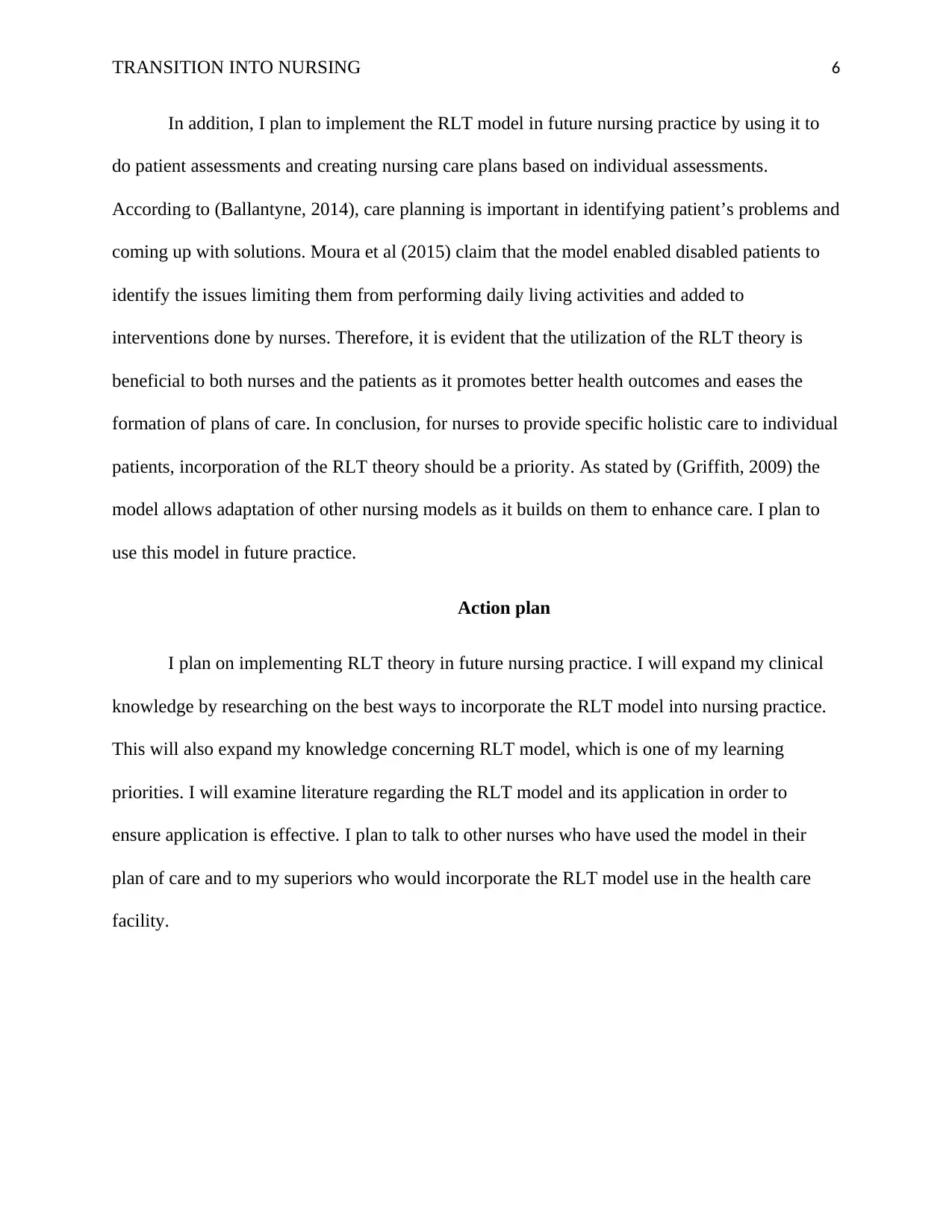
TRANSITION INTO NURSING 6
In addition, I plan to implement the RLT model in future nursing practice by using it to
do patient assessments and creating nursing care plans based on individual assessments.
According to (Ballantyne, 2014), care planning is important in identifying patient’s problems and
coming up with solutions. Moura et al (2015) claim that the model enabled disabled patients to
identify the issues limiting them from performing daily living activities and added to
interventions done by nurses. Therefore, it is evident that the utilization of the RLT theory is
beneficial to both nurses and the patients as it promotes better health outcomes and eases the
formation of plans of care. In conclusion, for nurses to provide specific holistic care to individual
patients, incorporation of the RLT theory should be a priority. As stated by (Griffith, 2009) the
model allows adaptation of other nursing models as it builds on them to enhance care. I plan to
use this model in future practice.
Action plan
I plan on implementing RLT theory in future nursing practice. I will expand my clinical
knowledge by researching on the best ways to incorporate the RLT model into nursing practice.
This will also expand my knowledge concerning RLT model, which is one of my learning
priorities. I will examine literature regarding the RLT model and its application in order to
ensure application is effective. I plan to talk to other nurses who have used the model in their
plan of care and to my superiors who would incorporate the RLT model use in the health care
facility.
In addition, I plan to implement the RLT model in future nursing practice by using it to
do patient assessments and creating nursing care plans based on individual assessments.
According to (Ballantyne, 2014), care planning is important in identifying patient’s problems and
coming up with solutions. Moura et al (2015) claim that the model enabled disabled patients to
identify the issues limiting them from performing daily living activities and added to
interventions done by nurses. Therefore, it is evident that the utilization of the RLT theory is
beneficial to both nurses and the patients as it promotes better health outcomes and eases the
formation of plans of care. In conclusion, for nurses to provide specific holistic care to individual
patients, incorporation of the RLT theory should be a priority. As stated by (Griffith, 2009) the
model allows adaptation of other nursing models as it builds on them to enhance care. I plan to
use this model in future practice.
Action plan
I plan on implementing RLT theory in future nursing practice. I will expand my clinical
knowledge by researching on the best ways to incorporate the RLT model into nursing practice.
This will also expand my knowledge concerning RLT model, which is one of my learning
priorities. I will examine literature regarding the RLT model and its application in order to
ensure application is effective. I plan to talk to other nurses who have used the model in their
plan of care and to my superiors who would incorporate the RLT model use in the health care
facility.
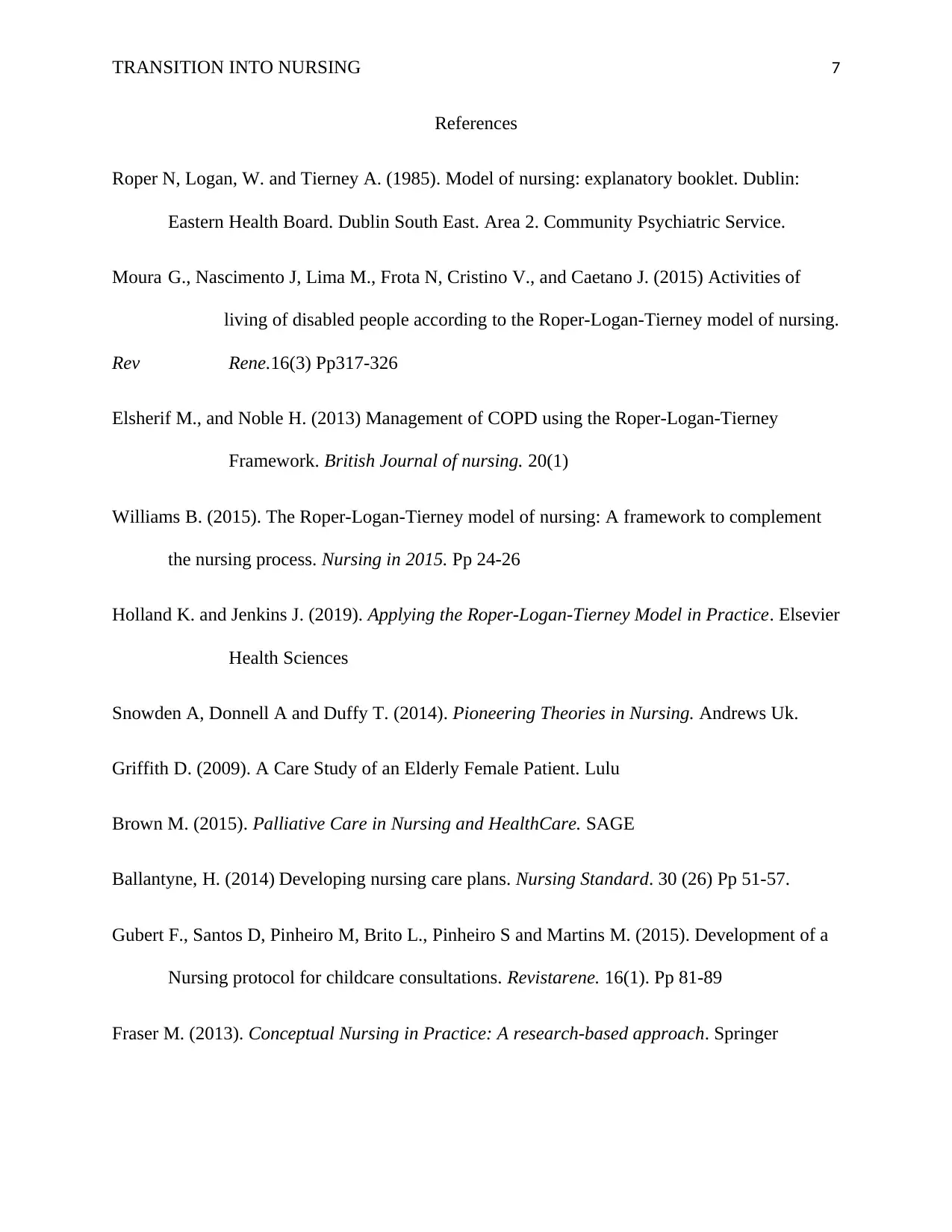
TRANSITION INTO NURSING 7
References
Roper N, Logan, W. and Tierney A. (1985). Model of nursing: explanatory booklet. Dublin:
Eastern Health Board. Dublin South East. Area 2. Community Psychiatric Service.
Moura G., Nascimento J, Lima M., Frota N, Cristino V., and Caetano J. (2015) Activities of
living of disabled people according to the Roper-Logan-Tierney model of nursing.
Rev Rene.16(3) Pp317-326
Elsherif M., and Noble H. (2013) Management of COPD using the Roper-Logan-Tierney
Framework. British Journal of nursing. 20(1)
Williams B. (2015). The Roper-Logan-Tierney model of nursing: A framework to complement
the nursing process. Nursing in 2015. Pp 24-26
Holland K. and Jenkins J. (2019). Applying the Roper-Logan-Tierney Model in Practice. Elsevier
Health Sciences
Snowden A, Donnell A and Duffy T. (2014). Pioneering Theories in Nursing. Andrews Uk.
Griffith D. (2009). A Care Study of an Elderly Female Patient. Lulu
Brown M. (2015). Palliative Care in Nursing and HealthCare. SAGE
Ballantyne, H. (2014) Developing nursing care plans. Nursing Standard. 30 (26) Pp 51-57.
Gubert F., Santos D, Pinheiro M, Brito L., Pinheiro S and Martins M. (2015). Development of a
Nursing protocol for childcare consultations. Revistarene. 16(1). Pp 81-89
Fraser M. (2013). Conceptual Nursing in Practice: A research-based approach. Springer
References
Roper N, Logan, W. and Tierney A. (1985). Model of nursing: explanatory booklet. Dublin:
Eastern Health Board. Dublin South East. Area 2. Community Psychiatric Service.
Moura G., Nascimento J, Lima M., Frota N, Cristino V., and Caetano J. (2015) Activities of
living of disabled people according to the Roper-Logan-Tierney model of nursing.
Rev Rene.16(3) Pp317-326
Elsherif M., and Noble H. (2013) Management of COPD using the Roper-Logan-Tierney
Framework. British Journal of nursing. 20(1)
Williams B. (2015). The Roper-Logan-Tierney model of nursing: A framework to complement
the nursing process. Nursing in 2015. Pp 24-26
Holland K. and Jenkins J. (2019). Applying the Roper-Logan-Tierney Model in Practice. Elsevier
Health Sciences
Snowden A, Donnell A and Duffy T. (2014). Pioneering Theories in Nursing. Andrews Uk.
Griffith D. (2009). A Care Study of an Elderly Female Patient. Lulu
Brown M. (2015). Palliative Care in Nursing and HealthCare. SAGE
Ballantyne, H. (2014) Developing nursing care plans. Nursing Standard. 30 (26) Pp 51-57.
Gubert F., Santos D, Pinheiro M, Brito L., Pinheiro S and Martins M. (2015). Development of a
Nursing protocol for childcare consultations. Revistarene. 16(1). Pp 81-89
Fraser M. (2013). Conceptual Nursing in Practice: A research-based approach. Springer
Paraphrase This Document
Need a fresh take? Get an instant paraphrase of this document with our AI Paraphraser
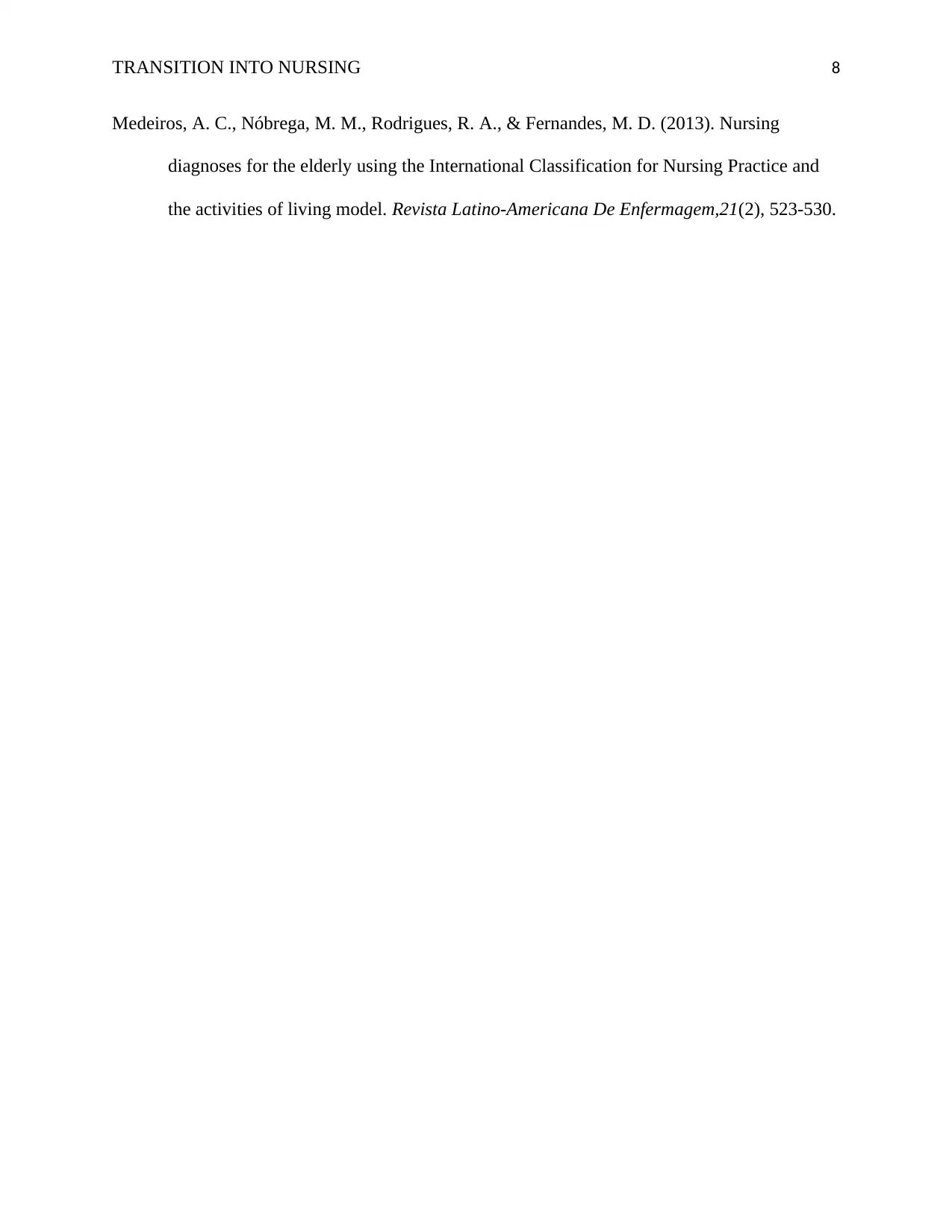
TRANSITION INTO NURSING 8
Medeiros, A. C., Nóbrega, M. M., Rodrigues, R. A., & Fernandes, M. D. (2013). Nursing
diagnoses for the elderly using the International Classification for Nursing Practice and
the activities of living model. Revista Latino-Americana De Enfermagem,21(2), 523-530.
Medeiros, A. C., Nóbrega, M. M., Rodrigues, R. A., & Fernandes, M. D. (2013). Nursing
diagnoses for the elderly using the International Classification for Nursing Practice and
the activities of living model. Revista Latino-Americana De Enfermagem,21(2), 523-530.
1 out of 8
Related Documents
Your All-in-One AI-Powered Toolkit for Academic Success.
+13062052269
info@desklib.com
Available 24*7 on WhatsApp / Email
![[object Object]](/_next/static/media/star-bottom.7253800d.svg)
Unlock your academic potential
© 2024 | Zucol Services PVT LTD | All rights reserved.




